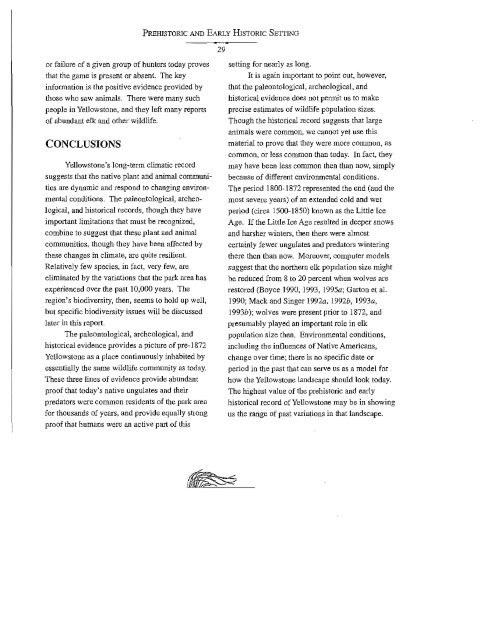Yellowstone's Northern Range - Greater Yellowstone Science ...
Yellowstone's Northern Range - Greater Yellowstone Science ...
Yellowstone's Northern Range - Greater Yellowstone Science ...
Create successful ePaper yourself
Turn your PDF publications into a flip-book with our unique Google optimized e-Paper software.
PREHISTORIC AND EARLY HISTORIC SETTING<br />
29<br />
or failure of a given group of hunters today proves<br />
that the game is present or absent. The key<br />
information is the positive evidence provided by<br />
those who saw animals. There were many such<br />
people in <strong>Yellowstone</strong>, and they left many reports<br />
of abundant elk and other wildlife.<br />
CONCLUSIONS<br />
<strong><strong>Yellowstone</strong>'s</strong> long-term climatic record<br />
suggests that the native plant and animal communities<br />
are dynamic and respond to changing environmental<br />
conditions. The paleontological, archeological,<br />
and historical records, though they have<br />
important limitations that must be recognized,<br />
combine to suggest that these plant and animal<br />
communities, though they have been affected by<br />
these changes in climate, are quite resilient.<br />
Relatively few species, in fact, very few, are<br />
elintinated by the variations that the park area has<br />
experienced over the past 10,000 years. The<br />
region's biodiversity, then, seems to hold up well,<br />
but specific biodiversity issues will be discussed<br />
later in this report.<br />
The paleontological, archeological, and<br />
historical evidence provides a picture of pre-I 872<br />
<strong>Yellowstone</strong> as a place continuously inhabited by<br />
essentially the same wildlife community as today.<br />
These three lines of evidence provide abundant<br />
proof that today's native ungulates and their<br />
predators were common residents of the park area<br />
for thousands of years, and provide equally strong<br />
proof that humans were an active part of this<br />
setting for nearly as long.<br />
It is again important to point out, however,<br />
that the paleontological, archeological, and<br />
historical evidence does not pennit us to make<br />
precise estimates of wildlife population sizes.<br />
Though the historical record suggests that large<br />
animals were common, we cannot yet use this<br />
material to prove that they were more common, as<br />
common, or less common than today. In fact, they<br />
may have been less common then than now, simply<br />
because of different environmental conditions.<br />
The period 1800-1872 represented the end (and the<br />
most severe years) of an extended cold and wet<br />
period (circa 1500-1850) known as the Little Ice<br />
Age. If the Little Ice Age resulted in deeper snows<br />
and harsher winters, then there were almost<br />
certainly fewer ungulates and predators wintering<br />
there then than now. Moreover, computer models<br />
suggest that the northern elk population size might<br />
be reduced from 8 to 20 percent when wolves are<br />
restored (Boyce 1990, 1993, 1995a; Garton et a!.<br />
1990; Mack and Singer 1992a, 1992b, 1993a,<br />
1993b); wolves were present prior to 1872, and<br />
presumably played an important role in elk<br />
population size then. Environmental conditions,<br />
including the influences of Native Americans,<br />
change over time; there is no specific date or<br />
period in the past that can serve us as a model for<br />
how the <strong>Yellowstone</strong> landscape should look today.<br />
The highest value of the prehistoric and early<br />
historical record of <strong>Yellowstone</strong> may be in showing<br />
us the range of past variations in that landscape.















